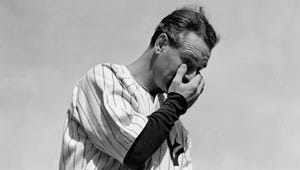
Murray Becker AP
As Cal Ripken Jr. circled the field at Camden Yards to accept congratulations for topping Lou Gehrig's consecutive games streak in 1995, he couldn't help thinking about the ill-fated star.
"His record was thought to be unbreakable," says Ripken, whose streak eventually reached 2,632 games. "Lou was in my thoughts, my speech and my talk with the media afterwards."
Gehrig played 2,130 games in a row until he was physically unable to play anymore. A dying man at age 36, Gehrig stepped to a Yankee Stadium microphone July 4, 1939, and told fans he was "the luckiest man on the face of the earth."
Seventy five years later, he is not only a Hall of Famer and New York Yankees legend, but his image and reputation also have grown almost larger than life.
"He was a player for the ages," says former Yankees publicist Marty Appel, author of Pinstripe Empire: The New York Yankees from Before the Babe to After the Boss. "He didn't need the support of Babe Ruth to be a great player. His performance on the field spoke for itself. His speech was a baseball moment that had nothing to do with playing. It was baseball's Gettysburg Address."
It can be argued, though, that Gehrig's legendary status began with his famous words.
"When Gehrig gave his speech, it was the first time many of the people in the ballpark heard him speak," Appel says. "Radio interviews were not that frequent, so people in the ballpark did not realize he had such a strong New York accent."
Gehrig, the son of poor German immigrants, had many qualities that belie his now-worldwide celebrity. He was quiet, dignified, soft-spoken and modest to a fault. He compiled gargantuan statistics without a gargantuan personality.
Ruth cast a giant shadow on and off the field. Other than both men batting left-handed and wearing Yankees pinstripes, Ruth and Gehrig were polar opposites, with Ruth craving the spotlight and Gehrig preferring privacy. Overshadowed by bombastic Ruth early in his career and polished Joe DiMaggio at the end, Gehrig was always the tortoise against somebody else's hare.
"If I stood on my head at the plate, nobody would pay any attention," Gehrig once said. "I'm just the guy who's in there every day, the fellow who follows Babe in the batting order.
"Whether he strikes out or hits a home run, the fans are still talking about him when I come up."
Even when he hit a home run, Gehrig was almost methodical in his gait, keeping his head down as he ran the bases. Doing this cost him a home run crown in 1931, when he passed Lyn Lary on the bases after hitting an apparent game-winning homer. Lary, seeing the ball clear the fence, went from third base to the Yankees dugout but Gehrig, deep into his trot, was ruled out when he passed the spot Lary left. Given a triple instead of a home run, Gehrig finished the year with 46, sharing league leadership with Ruth.
A year later on June 3, when he became the first American League player to hit four home runs in a game, the news was overshadowed by the sudden retirement of longtime New York Giants manager John McGraw.
That fall, Gehrig hit .529 with three home runs and eight RBI in a four-game World Series sweep of the Chicago Cubs. But fans and writers seemed obsessed with Ruth's "called shot" in Game3. Never mind that Gehrig followed it with a home run that provided what proved to be the game-winning run.
"If Gehrig had stayed healthy, we'd be debating whether he or Ted Williams was the greatest hitter of all time," says Jonathan Eig, author of Luckiest Man: The Life and Death of Lou Gehrig. "I think Gehrig is underrated. If he had played another four or five years — which was entirely possible considering the shape he kept himself in — he would have finished with the best numbers of anyone in the game."
Gehrig, a first baseman, did some things Ruth couldn't match: a four-homer game, a Triple Crown and stand-alone records of 500 RBI over a three-year span and 23 career grand slams.
An RBI machine, Gehrig knocked in 185 runs, an AL record, in 1931 and topped 150 in six other seasons.
"He was so proud of that," Eig says. "He always said he didn't care about home runs but that RBI were his baby."
Gehrig always maintained he wasn't a headline guy. His feats suggested otherwise. The New York native was handsome and muscular. He hit a ball out of Wrigley Field as a visiting high school All-Star, struck out 17 hitters as a pitcher at Columbia University and was 20 when he joined the Yankees in 1923, the same year old Yankee Stadium opened.
Yet he used his $1,500 bonus money to move his parents from the city to the suburbs and never earned more than $39,000 in a season even at the height of his career.
Today, he might own the team. He not only played every day but produced, hitting .340 during the regular season and .361 in seven World Series. A model of consistency, he had five 40-homer seasons without ever topping 49 and collected at least 109 RBI in every year from 1926 through 1938.
"I much preferred Gehrig to Babe Ruth," says Ray Robinson, author of Iron Horse: Lou Gehrig in His Time. "I liked my heroes shy and not full of themselves. I liked Lou's courteous, dignified and soft-spoken manner. So when they had Lou Gehrig Appreciation Day, I decided to go."


No comments:
Post a Comment